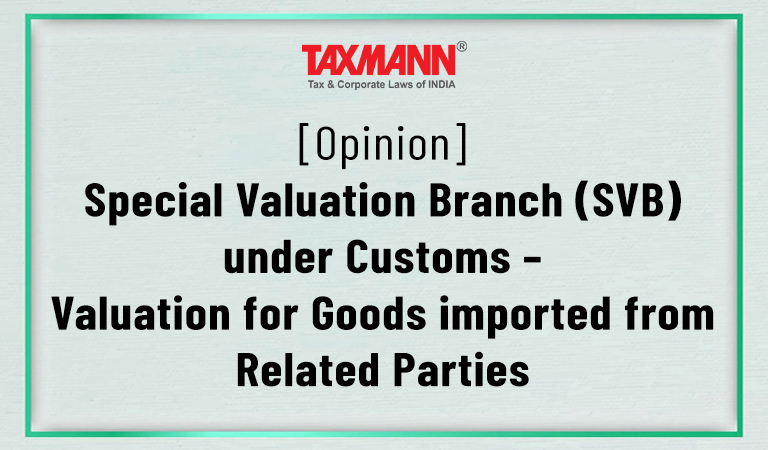[Opinion] Special Valuation Branch (SVB) under Customs – Valuation for Goods imported from Related Parties
- News|Blog|GST & Customs|
- 3 Min Read
- By Taxmann
- |
- Last Updated on 9 December, 2022

CA Ravi Kumar Somani & CA Yash Shah – [2022] 145 taxmann.com 320 (Article)
Introduction
Special Valuation Branch is a special unit of the Customs department which is specializing in investigating the transactions which are entered into by importer based out in India and a supplier based in foreign country who have relationship like joint ventures, partnerships, holding-subsidiary etc. which could possibly influence the price of the transaction entered. The main task of the special valuation branch is to verify that the relationship has not influenced the terms and conditions of the transaction and in turn the transaction value between the parties. Apart from investigation of special relationship case, SVB also handles more complicated cases of additions or deletions with respect to transaction value that has been declared by the importers under rule 10(1)(c) or rule 10(1)(d) or rule 10(1)(e) of the Customs Valuation (Determination of Value of Imported Goods) Rules, 2007.
Requirement of Special Valuation Branch as special unit
Import and Export transactions are the starting point for this special institution to be formed wherein the valuation mechanism adopted by the importer might be in terms of agreement not in line with the market scenario and some beneficial position as to importer and the other party might be adopted by the importer and due to this reason Customs department has issued Circular No. 1/98 dated 1-1-1998 making the Special Valuation Branch as a functional institution for the cases involving transactions between the related parties.
Both the circulars were issued upon the Customs Valuation (Determination of Price of Imported Goods) Rules, 1988 which has been now superseded by the Customs Valuation (Determination of Value of Imported Goods) Rules, 2007. Previously there were some stringent provisions in relation to regular renewals, provisional assessments, procedural part which were complex in terms of great time-consuming process & burdensome as to work which have been now streamlined and as per Circular No 05/2016 dated 9th February 2016.
The transactions undertaken by related parties differ from situation to situation where the transaction value might be impacted due to the relationship involved between the two parties. The definition of related parties’ changes from each law or statutory provision like in income tax, company law, accounting standards, SEBI, Goods and Service tax, and even in Customs. Hence whenever the relationship gets attracted by that particular provision of law, we need to go back to the provisions and check the relevant other facts of the provision with respect to either valuation, assessment, & other parameters and relevant adjustment with respect to such pricing would be required. We now analyze the meaning of the related party as referred to in Customs law.
Meaning of Related Parties
The relationship needs to be examined with respect to definition of related party under Rule 2(2) of the Customs Valuation (Determination of Value of Imported Goods) Rules, 2007 which is supplied here –
“(2) For the purpose of these rules, persons shall be deemed to be “related” only if –
i. they are officers or directors of one another’s businesses.
ii. they are legally recognized partners in business.
iii. they are employer and employee.
iv. any person directly or indirectly owns, controls, or holds five per cent or more of the outstanding voting stock or shares of both of them.
v. one of them directly or indirectly controls the other.
vi. both of them are directly or indirectly controlled by a third person.
vii. together they directly or indirectly control a third person; or
viii. they are members of the same family.Explanation I. – The term “person” also includes legal persons.
Explanation II. – Persons who are associated in the business of one another in that one is the sole agent or sole distributor or sole concessionaire, howsoever described, of the other shall be deemed to be related for the purpose of these rules, if they fall within the criteria of this sub-rule.”
Click Here To Read The Full Article
Disclaimer: The content/information published on the website is only for general information of the user and shall not be construed as legal advice. While the Taxmann has exercised reasonable efforts to ensure the veracity of information/content published, Taxmann shall be under no liability in any manner whatsoever for incorrect information, if any.

Taxmann Publications has a dedicated in-house Research & Editorial Team. This team consists of a team of Chartered Accountants, Company Secretaries, and Lawyers. This team works under the guidance and supervision of editor-in-chief Mr Rakesh Bhargava.
The Research and Editorial Team is responsible for developing reliable and accurate content for the readers. The team follows the six-sigma approach to achieve the benchmark of zero error in its publications and research platforms. The team ensures that the following publication guidelines are thoroughly followed while developing the content:
- The statutory material is obtained only from the authorized and reliable sources
- All the latest developments in the judicial and legislative fields are covered
- Prepare the analytical write-ups on current, controversial, and important issues to help the readers to understand the concept and its implications
- Every content published by Taxmann is complete, accurate and lucid
- All evidence-based statements are supported with proper reference to Section, Circular No., Notification No. or citations
- The golden rules of grammar, style and consistency are thoroughly followed
- Font and size that’s easy to read and remain consistent across all imprint and digital publications are applied



 CA | CS | CMA
CA | CS | CMA
